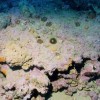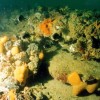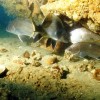The Tegnùe. This term is used to indicate the natural rocky outcroppings that occur irregularly in the western area of the Venetian Gulf, at depths of from 8 to 40 metres.
Sometimes covering just a few square metres, sometimes thousands, they might rise just a few dozens centimetres off the sea bed (in the lastrure base formations) or, in places of greatest depth, up to a few metres.
Geological studies have revealed these outcroppings to comprise three different types of rock: sedimentary clastic rock (commonly known as ‘beachrocks’); sedimentary rocks deposited through chemical processes, and ‘organogenous’ rock (that is, produced by the action of plant or animal organisms).
The presence of ‘islands’ of solid substratum in the sandy/muddy seabed creates small local ecosystems that stimulate bio-diversity. These ‘oases’ not only contain a high number of species but also a sizeable bio-mass per unit of area. The many species present include Poriferae, Coelenterates, Annelids, and numerous Serpulids that cover every available layer in successive strata. There are also various species of Echinoderms amongst the typical inhabitants of the tegnùe, as well as numerous species of Tunicates. The fish species include such prized specimens as the homarus gammarus lobster, the Sciaena Umbra, the Umbrina cirrosa Umbrine, the Trispterus minutus striped bream, the Conger conger eel and the Dicentrarchus labrax sea bass. These are, in fact, the only local environments in which certain species – for example, the lobster – are to be found.


